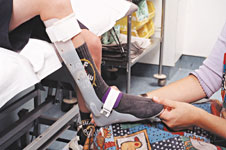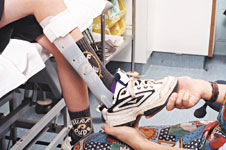Ankle-foot orthoses (AFOs) are among the most commonly
prescribed lower limb orthoses. They are custom made for each
individual to encompass the foot, ankle and leg, finishing just
below the knee. Made from high temperature thermoplastic AFOs are
supplied to combat a variety of factors, these may include muscle
weakness, joint instability and high muscle tone.
Fitted with a variety of purposes in mind including controlling
alignment, increasing mobility and independence, assisting
rehabilitation and/or to reduce pain, AFOs are also provided with
the intention of preventing deformity occurring. Depending on a
child's needs they may be hinged (made to bend at the ankle) or
solid (no movement at the ankle) and fitted on either one or both
legs. This information sheet aims to inform parents and carers what
AFOs are, what they do, what to expect in a casting, fitting and
review appointments and how to care for both the child and the
AFO.
AFO Prescriptions
In order to receive an AFO a valid referral is required, both
public and private referrals are accepted however private patients
are subject to fees for both the orthoses and clinical time. Once a
referral is gained an appointment will be made for casting of the
AFO.
Casting Appointment
On the appointment day it is essential for the clinician to
assess the lower leg; this means either wearing clothing that
finishes at or above the knee or pants/skirts that can be rolled up
above the knee. During this appointment the clinician may ask you
to walk and also test ranges of motion of the leg and foot to
ascertain your functioning capabilities and typical walking
pattern.
A 'negative' cast will be taken of the leg/s as required by
rolling plaster bandage around the leg, waiting until it sets (3-6
minutes), and taking it off again. From this cast your AFOs will be
made. The production process takes 3-4 weeks until the AFOs are
ready to fit. An appointment to collect your AFOs will be made on
the day of casting.
Fitting Appointment
A few things are required at your fitting appointment, these
include:
The lower leg should be exposed or easily accessible, similar
to your casting appointment.
Bring along knee high socks that fit well and are relatively
wrinkle free.
Bring your current runners or school shoes.
At this appointment the AFO has been roughly trimmed to fit your
leg and will require some adjustment and addition of straps before
the final fitting and completion of your orthoses. This occurs on
the same day. The total process should take from 40-90 minutes,
with the clinician leaving the room for periods of time to do any
modifications. You may wish to bring along a book, electronic game
system, personal listening device or the like to pass the time.

AFOs At Home
Fitting an AFO
Here are a few points for fitting and wearing an AFO
Your child should wear knee high cotton socks or tights under
the AFO, this will reduce any rubbing.
If your child has an AFO for each foot, make sure that you are
putting them on the correct feet.
When you put the AFO on your child, bend their knee to 90
degrees (a right-angle) or more and push the heel down and back
into the heel of the AFO. It can help to gently lift your child's
toes upwards to check that his or her heel is right down in the
heel section of the AFO.
Firstly fasten the ankle strap firmly, then the calf strap.
Make sure all the straps are fastened securely.
Once the AFO is on, your child's shoe can now be worn over the
orthoses and your child's foot.
Your child should always wear shoes or runners with the AFO
unless he or she only wears them in bed. Runners are ideal as they
are wider and deeper than normal shoes. You may need to remove the
insole to give you extra room.

Removing the AFO
When you remove your child's AFO, always check his or her skin.
Sometimes AFO's cause a slightly red line around the edge of the
orthosis, but this should disappear within half an hour or so. If
your child has any pain or skin marks that do not disappear within
half an hour or develops blisters, you should contact your
orthotist as soon as possible.
Looking after the AFO
The AFO should be regularly cleaned by wiping with a damp cloth
and soapy water. After cleaning, it should be completely dry before
being reapplied. Do not use a heat source, e.g. hair dryer or
tumble drier to dry your AFOs.
It is not uncommon that straps or padding become worn or break.
Contact the department as these are only minor repairs and can
often be completed quickly.
Similarly if you think your child is outgrowing the AFO also
contact the department to make an appointment. It takes two or
three weeks to get an appointment and two or three weeks to make an
AFO, so call in plenty of time.
Don'ts with AFOs
Don't cut, file, heat or damage your AFO(s)
Don't wear socks with wrinkles or that have a 'lumpy'
texture
Try not to wet the straps when washing your AFO(s). If
required towel dry straps only.
Do not leave AFO(s) to soak or attempt to dry it with heat,
e.g. hair drier, direct sunlight.
For more information
Please contact your orthotist if you have any queries or
concerns regarding your child's treatment with AFOs
Royal Children's Hospital
Orthotic and Prosthetic Unit
Flemington Road
Parkville 3052
orthotic.prosthetic@rch.org.au
Tel: (03) 9345 9300
Produced by the Royal Children's
Hospital (RCH) department of Orthotics.
Disclaimer: The information contained on the
site is intended to support not replace discussion with your doctor
or health care professionals. The authors accept no responsibility
for any inaccuracies, information perceived as misleading, or the
success of any treatment regimen detailed in the handouts.